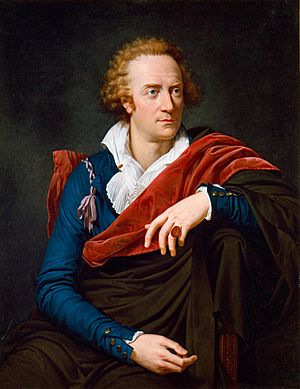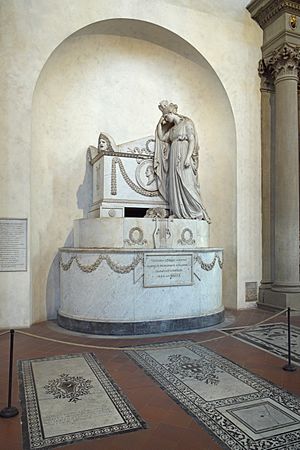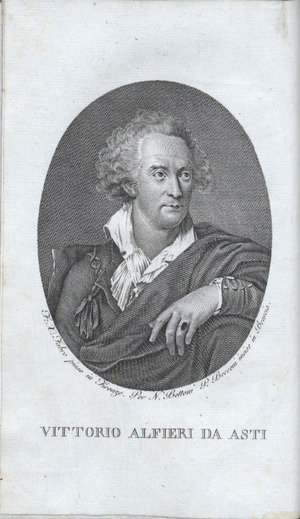Vittorio Alfieri facts for kids
Quick facts for kids
Vittorio Alfieri
|
|
|---|---|

Alfieri painted in Florence, 1793
|
|
| Born | Vittorio Amedeo Alfieri 16 January 1749 Asti, Kingdom of Sardinia |
| Died | 8 October 1803 (aged 54) Florence, Kingdom of Etruria |
| Resting place | church of Santa Croce, Florence |
| Occupation | dramatist, poet |
| Genre | tragedy |
| Signature | |
Count Vittorio Alfieri (born January 16, 1749 – died October 8, 1803) was an Italian writer. He is known as the "founder of Italian tragedy." He wrote many plays, poems, and his own life story.
Contents
Early Life and Travels
Vittorio Alfieri was born in Asti, a city that was then part of the Kingdom of Sardinia. His father died when he was very young. His mother raised him until he was ten. Then, he went to a special school in Turin.
When he was thirteen, Alfieri started studying law. But he was more interested in books, especially French adventure stories. At fourteen, he became rich when his uncle died and left him more money. He also started riding horses, which he loved his whole life.
In 1766, Alfieri got permission to travel. He went to Paris, but he didn't like France or its people. In the Netherlands, he fell in love with a married woman. When she left with her husband, Alfieri felt sad and went home. He started reading again, and a book called Plutarch's Lives made him love freedom.
He traveled again, visiting places like Sweden. He liked the wild, lonely places there because they fit his deep and sometimes sad thoughts. In London, he had a public affair with a married woman, which caused a big scandal. He then visited Spain and Portugal, where he met a friend named Abbe Caluso. In 1772, Alfieri returned to Turin. He fell in love again, and this time, he started writing a play. This play, called Cleopatra, was performed in Turin in 1775.
Becoming a Famous Writer
After Cleopatra, Alfieri wanted to be a famous playwright. He spent the rest of his life working on plays. His first two tragedies, Filippo and Polinice, were first written in French. To make his Italian better, he moved to Tuscany. There, he finished these plays and got ideas for more.
In Tuscany, he met Princess Louise of Stolberg-Gedern, also known as the Countess of Albany. She was married to Charles Edward Stuart ("Bonnie Prince Charlie"). Alfieri fell in love with her. To stay in Florence near her, he gave most of his money to his sister, keeping only a small amount for himself.
Louise left her husband because he treated her badly. She moved to Rome, and Alfieri followed her. In Rome, he wrote fourteen more tragedies. To protect Louise's reputation, he left Rome in 1783 and traveled around Italy. He also went to England to buy horses.
When he returned, he found Louise in Alsace, France. They lived together for the rest of his life, mostly in Paris. Alfieri planned to publish his plays there. But the French Revolution started, and he had to leave Paris. He and Louise moved to Florence, Italy. The last ten years of his life in Florence were his happiest.
Alfieri's writings helped create the revolutionary mood of his time. His essay Della Tirannide spoke out against absolute rulers and supported freedom for everyone. In another work, he said that poets should speak for freedom and human dignity. He supported the American Revolution and even dedicated a play to George Washington.
At first, he liked the French Revolution's ideas of freedom. But when the Reign of Terror became violent, he turned against the radical group called the Jacobins. Even though he didn't like the French anymore, he was honored when the French army came to Italy. Napoleon himself watched a performance of Alfieri's play Virginia. Alfieri's ideas continued to inspire Italian liberals and republicans for many years.
He spent his final years studying Greek and writing comedies. This hard work made him sick. He didn't listen to his doctors, which made him worse. He died in Florence in 1803. His last words were, "Clasp my hand, my dear friend, I die!" He is buried in the Church of Santa Croce, Florence, next to Niccolò Machiavelli.

Alfieri's Personality
You can learn a lot about Alfieri from his own book, Memoirs of his Life. He was easily annoyed and had a strong, sometimes wild, temper. He was very proud, which explains some of his actions. But studying literature helped him a lot. It made him calmer and more polite. He was also very loyal to his family and friends. He was generous and had a strong, noble spirit. These qualities helped him write plays about brave Greek heroes.
His Impact on Italian Literature
Alfieri is famous mainly for his plays. Before him, Italian plays were often boring. The plays of the 16th century were too serious and dull. Later plays were often wild and unbelievable. Alfieri's plays changed this. They were a very important event in Italian literature in the 1700s.
His plays changed over time. His first four tragedies, Filippo, Polinice, Antigone, and Virginia, had a very plain and sometimes harsh style. He improved this in his later plays, especially in Saul, which was his most popular work. People liked his simple, direct style.
Alfieri did not invent the plots for his plays. He used stories from old myths or history. Many of these stories had been used by Greek playwrights before. For example, Rosmunda is based on old stories.
A key part of all Alfieri's tragedies is the main character. This character is always a "hero of freedom." They are ambitious and want to start a revolution. They fight against unfair rulers and oppression. Often, they even kill the tyrant and face death themselves. This desire for freedom makes the hero feel alone and sad. They know that most people don't understand their fight, and their goals are almost impossible. This idea is called titanism.
Alfieri's plays are like old Greek plays. They show a strong love for freedom. For example, his plays Agide and Bruto are more like speeches about liberty than typical tragedies. He focused on one main action and one strong feeling in each play. He tried to remove anything extra. He also avoided big special effects or deep philosophical thoughts. He wanted his language to be simple and clear. Sometimes, this made his writing sound a bit stiff or too short.
Alfieri was very good at showing different characters. In Filippo, he shows a dark and mysterious ruler. In Polinice, the two rival brothers are very different. In Maria Stuarda (Mary Stuart), the queen is shown as trusting but also easily angered. In Mirra, the father Ciniro is a perfect king, and Cecri is a model wife and mother. He was also good at showing characters who were losing their minds. The madness of Saul is shown very well. Orestes' joy after killing Aegisthus turns into madness when he realizes he also accidentally killed his mother.
Alfieri is seen as the founder of a new style in Italian drama. Italy saw him as its only great tragic poet. Other writers who came after him looked to his strong, simple, and fast style as the best way to write tragedies.
Besides his tragedies, Alfieri also wrote many sonnets (a type of poem). He wrote five odes (poems of praise) about American independence. He also wrote a special type of play called a tramelogedia, Abele. His prose works include Panegyric on Trajan, which praises an old Roman emperor. His books La Tirannide and Essays on Literature and Government are known for their strong writing. His Antigallican looked at the French Revolution from a historical and critical point of view.
After he died, his other works were published. These included satires (writings that make fun of things) and six political comedies. His Memoirs of his Life is still read today.
Death
Alfieri got sick on October 3, 1803, after being out driving. His health got worse, and he died in his chair on October 8. He was buried in the church of Santa Croce, Florence. Louise, his companion, asked a famous artist named Antonio Canova to create a monument for him. It took six years to build and was placed in Santa Croce in 1810.
Freemasonry
Vittorio Alfieri was part of a group called the Masonic Lodge "Vittoria" in Naples. This group was linked to the Gran Loggia Nazionale "Lo Zelo." Many of Alfieri's friends were also Freemasons. Documents show that he was listed as "Count Alfieri, Gentleman of Turin" in a list of members in 1782. Later, the Savoia family banned Masonic activities in Piedmont. Naples then became an important center for Italian Freemasonry.
Works
Tragedies
- Published in 1783
- Fillipo (Philip)
- Polinice (Polynices)
- Antigone
- Virginia
- Agaménnone (Agamemnon)
- Oreste (Orestes)
- Rosmunda
- Ottavia (Octavia)
- Timoleone (Timoleon)
- Merope
- Published in 1788
- Maria Stuarda (Mary Stuart)
- La Congiura De'Pazzi (The Conspiracy of the Pazzi)
- Don Garzia (Don Garcia)
- Saul
- Agide (Agis)
- Sofonisba (Sophonisba)
- Published in 1792
- Bruto Primo (The First Brutus)
- Mirra (Myrrha)
- Bruto Secondo (The Second Brutus)
- Published posthumously in 1804
- Abéle (Abel)
- Le Due Alcesti (Alcestis II)
- Antony and Cleopatra
English translations of all 22 tragedies were done by Charles Lloyd and Edgar Alfred Bowring.
See also
 In Spanish: Vittorio Alfieri para niños
In Spanish: Vittorio Alfieri para niños


